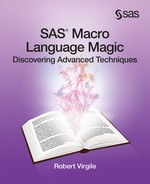Part 1: Preparation
What makes a macro look like magic? How can a short macro enable an end user to generate sophisticated, accurate results? To write such macros, programming wizards apply their knowledge, boosted by creativity and years of experience. Of course, preparation begins with:
• Reading
• Taking courses
• Programming
But magical results require more preparation than that. Behind the scenes, these same programming wizards also:
• Strive to write simple programs.
• Keep up with advances in the software.
• Experiment to determine how the software really works.
They appreciate the relationship between the SAS language and macro language. The vast majority of macro applications generate SAS code. As a result, any steps that improve your SAS skills will broaden the range of SAS programs you can envision and increase the value of the macro language. These steps go hand in hand:
• Expand your knowledge of SAS software.
• Select a simpler, more appropriate SAS tool to accomplish a programming task.
• Write simpler, more powerful macros.
The first two chapters of this book illustrate these preparatory steps. Chapter 1, “SAS Language Preparation,” focuses on the SAS language with a little bit of macro language mixed in. Chapter 2, “Shifting Gears: Macro Language,” shifts the focus more heavily into the macro language.
